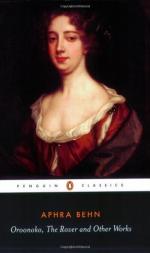|
This section contains 1,217 words (approx. 4 pages at 400 words per page) |

|
The term "apparatus" draws together several related aspects in theater production: the hierarchy of economic control, the material features of machinery and properties, and, more elusively, the social and psychological interplay between stage and audience. When Aphra Behn wrote her seventeen plays (1670-1689), the theatrical hierarchy, like all cultural institutions, was patriarchal in control and participation. Charles II invested power in the first patentees, Thomas Killigrew and William D'Avenant; aristocratic or upper-class males generally wrote the plays, purchased the tickets, and formed the coteries of critics and "witlings" whose disruptive presence is remarked on in countless play prologues and epilogues. In its machinery and properties, the Restoration stage was not unlike Wagner's theater in Adorno's critique: dreamlike, seductive, and commodity-intensive. Though the technology was well established in Italian and French courts, and in English court masques before the Interregnum, the two new Restoration theaters gave Londoners their...
|
This section contains 1,217 words (approx. 4 pages at 400 words per page) |

|




